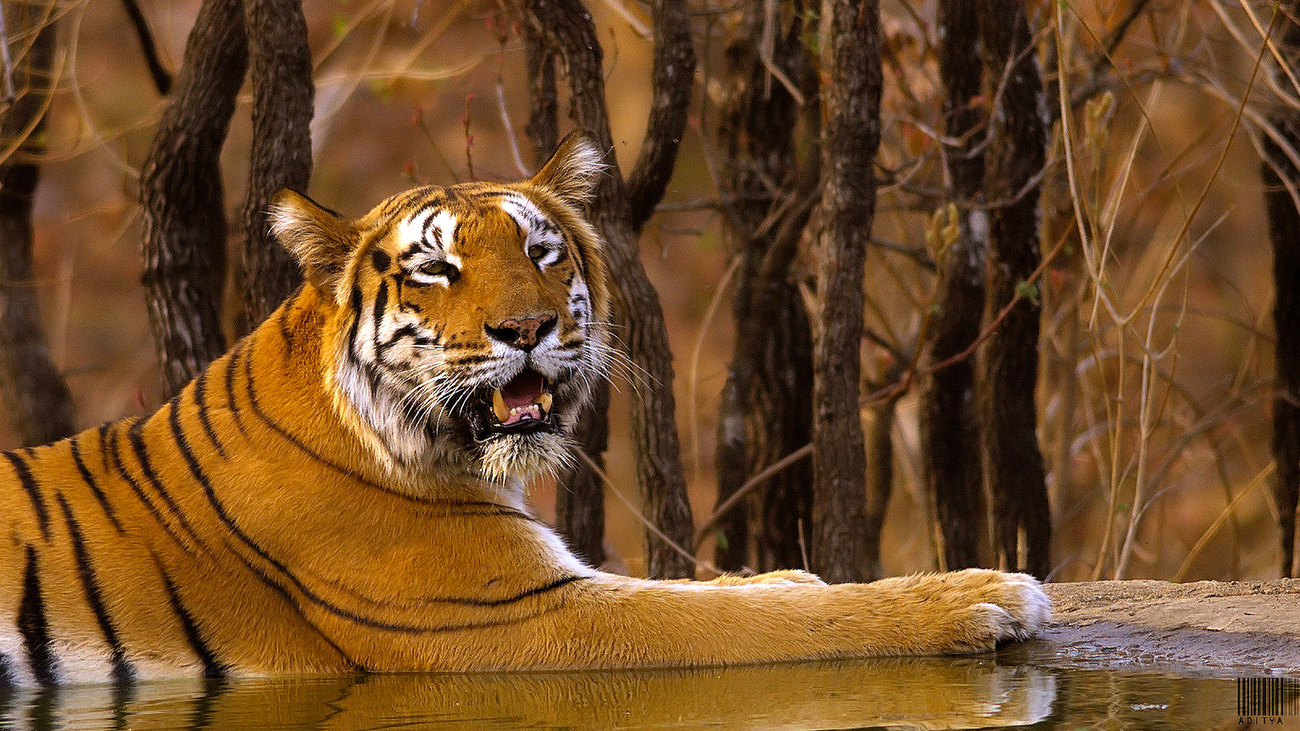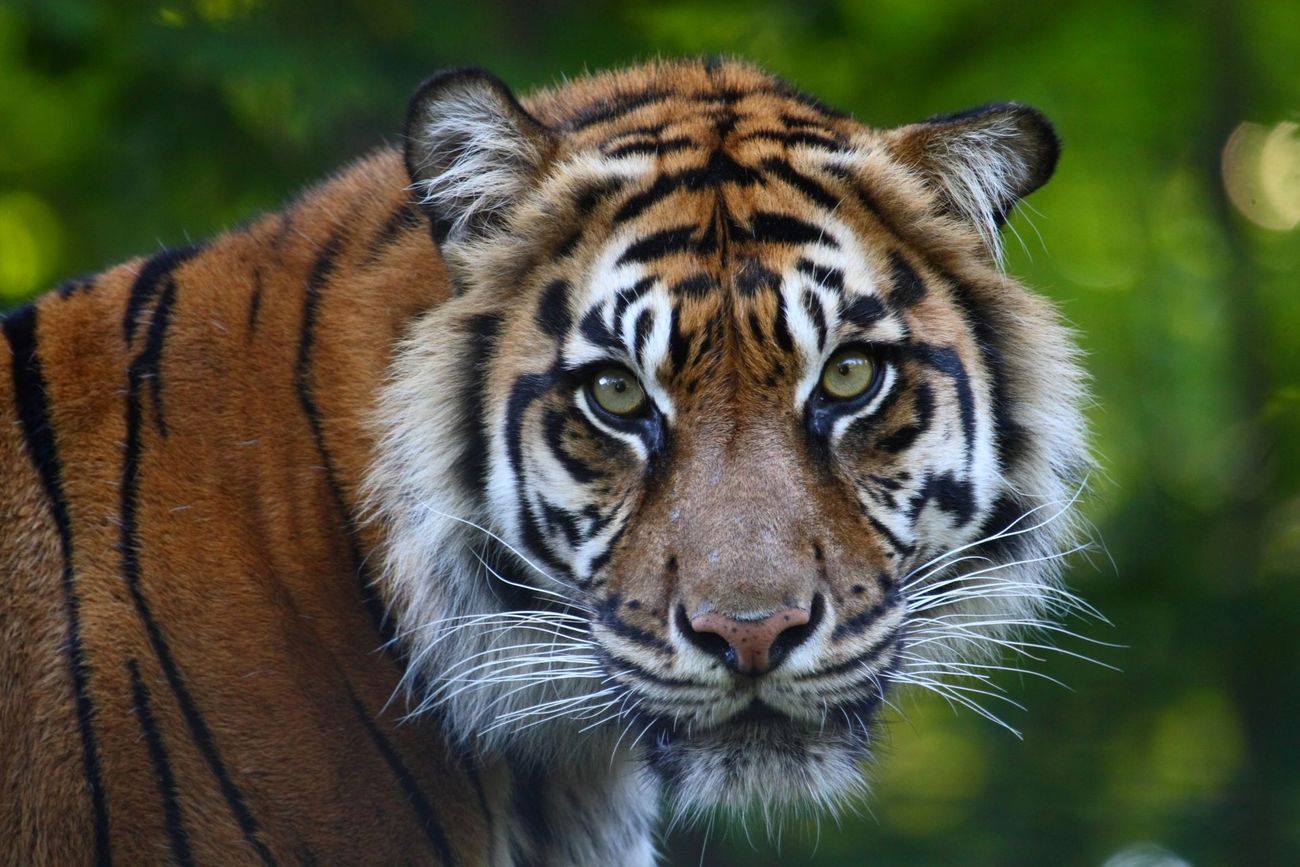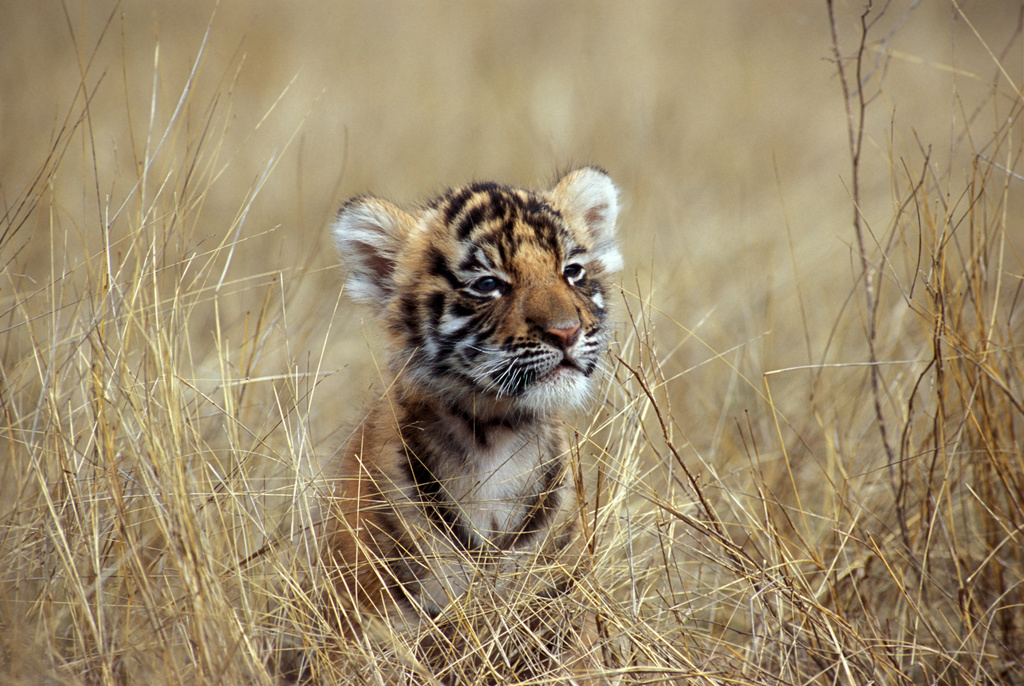Tigers
Tigers are the largest of all cats and one of the most iconic animals in the world.
Female tigers typically give birth to two to four cubs every two years, but over half of all tiger cubs don’t survive past their second birthday, which is when they usually separate from their mothers. Those who do survive beyond infanthood spend their lives as solitary hunters. They use their camouflaging stripes (which are unique to each tiger), agility, and fearsome strength to catch a wide range of prey.
Tigers are apex predators, which means they sit at the top of the food chain within their ecosystem. It also means they play a crucial role in maintaining ecosystems. Because tigers eat herbivores, such as deer, they help keep herbivore numbers under control. In doing so, they protect the land from overgrazing and degradation, which would damage the ecosystem and put other species at risk.
It’s not just animals who rely on functioning ecosystems. People rely on their local environment for food, water, and resources too. As predators, tigers help humans, wildlife, and the environment.
Want to learn more amazing facts about tigers and how you can help protect them? Let’s dive right in.
What is a tiger’s scientific name?
The scientific name for tigers is Panthera tigris.
There are five subspecies of tiger, each of which has its own scientific name. The Bengal tiger is known as Panthera tigris tigris, the South China tiger as Panthera tigris amoyensis, the Indochinese tiger as Panthera tigris corbetti, the Sumatran tiger as Panthera tigris sumatrae, and the Amur tiger (also known as the Siberian tiger) as Panthera tigris altaica.
Three subspecies of tiger are now extinct. These include the Caspian tiger (Panthera tigris virgata), the Bali tiger (Pantera tigris balica), and the Javan tiger (Panthera tigris sondaica).
What is a tiger’s conservation status?
The IUCN Red List of Threatened Species lists tigers as “endangered.” This means tigers face a very high risk of extinction in the wild. This is due to a number of threats, including poaching, habitat loss, climate change, human conflict, and illegal tiger farms.
Where do tigers live?
Tigers can live in a wide variety of habitats, including rainforests, grasslands, mangrove swamps, and even snowy coniferous forests. They live in temperatures ranging from -40°C to 40°C, as each subspecies has adapted to its environment. Tigers in snowy northeast Asia, for example, are larger and have longer hair to cope with the colder weather.
Native to Asia, tigers could be found throughout the continent only a century ago, including in Turkey and Afghanistan. Now, they occupy a much smaller territory, having lost around 95% of their historical habitat. Today, tigers live in ten Asian countries, with the largest numbers found in India and Russia. There are smaller tiger populations in Bangladesh, Bhutan, China, Indonesia, Malaysia, Myanmar, Nepal, and Thailand.
Threats
Tigers face a number of threats. Poaching, habitat loss, human-wildlife conflict, climate change, and illegal tiger farms all impact the tiger population.
Poaching
Tiger bones have been used in traditional Asian medicine, while tiger pelts and teeth are also sought after as status symbols in some cultures. Because of this, tigers are often poached for their parts, which are then sold in illegal wildlife markets.
Habitat loss
The expansion of agriculture, logging, and human settlement has reduced tigers’ habitat to just 5% of their historical territory. This is a significant problem, as tigers need a large territory in order to survive. If they become isolated or less connected, it becomes very difficult for them to hunt and mate.

Human-wildlife conflict
Shrinking habitats lead tigers to look for food and territory beyond their usual boundaries. This means they’re more likely to come into contact with humans and their livestock. When tigers prey on livestock, farmers hunt and kill them either in retaliation or to protect their livelihoods.
Climate change
Climate change poses a unique challenge for tigers living in the Sundarbans, a large area of mangrove forests in India and Bangladesh. Rising sea levels could soon wipe out the forest, along with these tigers and their prey.
Tiger farms
Around 8,000 tigers are thought to be held in captivity in Asia, where they are used for breeding, body parts, and illegal live animal trade. Tiger farms and zoos are a problem in the United States too. In the US, as many as 10,000 big cats live in captivity, kept in backyard cages and private zoos that masquerade as sanctuaries. Many of them live in terrible conditions and experience regular abuse.
FAQs
Do tigers roar? How long do tigers live? What do tigers like to eat? Let’s take a look at some incredible facts about tigers.
What do tigers eat?
Tigers are carnivores who prefer to eat medium-sized and large mammals. They are stealthy, solitary hunters and can consume as much as 36 kilograms of meat in one sitting. The exact type of prey they eat depends on their habitat.
Bengal tigers living in India, Bangladesh, Bhutan, and Nepal enjoy a diet of deer, water buffalo, bison, and antelope. They also sometimes eat leopards, monkeys, and bears.
The Amur tiger, living primarily in Russia, tends to eat elk, deer, and wild boar. They will also hunt smaller animals, like rabbits and hares, and will even go fishing for salmon.
Other tiger species are known to eat animals as varied as porcupines, wild boars, crocodiles, tapirs, peacocks, and injured elephant calves.
How much do tigers weigh?
Tigers can weigh anything from 100 to 300 kilograms and measure between 1.8 and 3 metres long.
Males are bigger and heavier than females, while the Amur tiger is the biggest tiger subspecies and comes in at the heavier and longer ends of the scale.
Are there tigers in Africa?
Contrary to popular belief, there are no tigers in Africa. Tigers live exclusively in Asia.

How long do tigers live?
Tigers in the wild can live for up to 20 years. They gain independence from their mother at around age 2 and reach sexual maturity between ages 3 and 5.
Do tigers roar?
Yes, tigers roar. Along with their big cat cousins—lions, leopards, and jaguars—tigers have a specially adapted bone in their neck that allows them to roar. The same adaptation means they can’t purr.
A tiger’s roar can be heard up to three kilometres away.
Are tigers endangered?
On the IUCN Red List of Threatened Species, tigers are listed as “endangered,” meaning they are at a high risk of extinction.
How many tigers are left in the world?
Sadly, the IUCN estimates that there are only between 2,608 and 3,140 mature tigers left in the wild.
Our work
IFAW works closely with partners, governments, and local communities to secure a better future for tigers.
In India, we work with the Wildlife Trust of India (WTI) in collaboration with Assam Forest Department to help protect tigers living in Kaziranga National Park. Annual floods displace these animals, forcing tigers in the park to seek out higher ground for safety—often near or within neighbouring communities. Our teams rescue tigers in need and provide them with lifesaving veterinary care.
IFAW-WTI has been working in Central India for over a decade, mitigating human-tiger conflicts, allowing safe passage to moving tigers, reducing human pressures on already fragmented corridors, and integrating stakeholder support in conservation management of tiger habitats. IFAW-WTI has also worked to strengthen protection for these big cats amongst other species by capacity building frontline staff (rangers), providing legal and enforcement assistance to wildlife enforcement agencies, and conducting anti-snare walks in critical tiger habitats.
In 2018, we helped launch the Coalition to End Wildlife Trafficking Online. As part of the coalition, companies and wildlife experts from around the world came together to develop an approach to reducing wildlife trafficking online. Since then, online technology companies within the coalition have removed or blocked over twelve million online advertisements for endangered and threatened species, including tigers.
We work to protect tigers in the US too. In 2017, we established the Big Cat Sanctuary Alliance (BCSA), a network of sanctuaries that cooperate to ensure that captive tigers have a safe place to go when they are rescued. At the federal policy level, we also worked to pass the Big Cat Public Safety Act. This legislation, signed into law in December 2022, made private ownership of big cats and physical contact between the public and captive big cats illegal. As a result of these combined efforts, since 2003, we’ve rescued 189 captive big cats and placed them in legitimate sanctuaries.

How can you help?
Tigers play an important role in maintaining ecological balance, but they face many human-made threats. You can help create a better future for these beautiful animals. Donations help fund our conservation programs and projects around the world.
